手术讲解模板:听骨链重建术
- 格式:ppt
- 大小:328.00 KB
- 文档页数:68


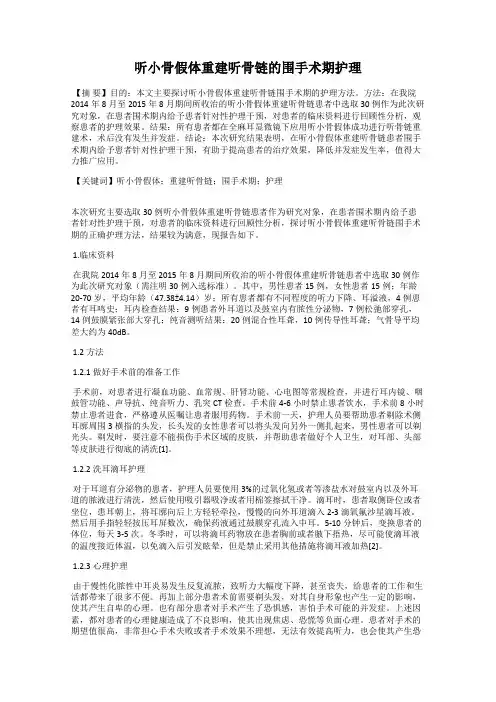
听小骨假体重建听骨链的围手术期护理【摘要】目的:本文主要探讨听小骨假体重建听骨链围手术期的护理方法。
方法:在我院2014年8月至2015年8月期间所收治的听小骨假体重建听骨链患者中选取30例作为此次研究对象,在患者围术期内给予患者针对性护理干预,对患者的临床资料进行回顾性分析,观察患者的护理效果。
结果:所有患者都在全麻耳显微镜下应用听小骨假体成功进行听骨链重建术,术后没有发生并发症。
结论:本次研究结果表明,在听小骨假体重建听骨链患者围手术期内给予患者针对性护理干预,有助于提高患者的治疗效果,降低并发症发生率,值得大力推广应用。
【关键词】听小骨假体;重建听骨链;围手术期;护理本次研究主要选取30例听小骨假体重建听骨链患者作为研究对象,在患者围术期内给予患者针对性护理干预,对患者的临床资料进行回顾性分析,探讨听小骨假体重建听骨链围手术期的正确护理方法,结果较为满意,现报告如下。
1.临床资料在我院2014年8月至2015年8月期间所收治的听小骨假体重建听骨链患者中选取30例作为此次研究对象(需注明30例入选标准)。
其中,男性患者15例,女性患者15例;年龄20-70岁,平均年龄(47.38±4.14)岁;所有患者都有不同程度的听力下降、耳溢液,4例患者有耳鸣史;耳内检查结果:9例患者外耳道以及鼓室内有脓性分泌物,7例松弛部穿孔,14例鼓膜紧张部大穿孔;纯音测听结果:20例混合性耳聋,10例传导性耳聋;气骨导平均差大约为40dB。
1.2方法1.2.1做好手术前的准备工作手术前,对患者进行凝血功能、血常规、肝肾功能、心电图等常规检查,并进行耳内镜、咽鼓管功能、声导抗、纯音听力、乳突CT检查。
手术前4-6小时禁止患者饮水,手术前8小时禁止患者进食,严格遵从医嘱让患者服用药物。
手术前一天,护理人员要帮助患者剃除术侧耳廓周围3横指的头发,长头发的女性患者可以将头发向另外一侧扎起来,男性患者可以剃光头。

仿真内窥镜法听骨链重建在中耳炎患者的应用韩正理刘云李郧叶发贵深圳市宝安区福永医院广东省深圳市 518103 【摘要】目的探讨仿真内窥镜法听骨链重建对判断听骨链病变的价值。
方法应用仿真内窥镜法听骨链重建成像与术中所见进行回顾性分析,分析比较仿真内窥镜法听骨链重建与术中病变所见的符合情况。
结果仿真内窥镜法听骨链重建对病变听骨链的诊断准确率与术中对照符合率较高,显示高分辨率CT对砧骨病变的显示与术中所见一致性非常好。
结论应用仿真内窥镜法听骨链重建能对听骨链病变程度做出准确判断。
【关键词】仿真内窥镜法;中耳炎;听骨链;中耳乳突手术Virtual endoscopy method ossicular reconstruction in patients with otitis media applicationsHAN Zheng-li * LIU Yun Li-Yun YE Fa-gui*Department of Otarhinolaryngology , Fuyong Hospital , Shenzhen 518103,China [Abstract] Objective Through the application of otitis media in patients with preoperative virtual endoscopy ossicular reconstruction images with the intraoperative comparative analysis to explore the virtual endoscopy method of ossicular reconstruction to determine the value of ossicular lesions. Methods 48 cases of complete information on chronic suppurative otitis media hospitalized patients into the study, its method of preoperative virtual endoscopy ossicular reconstruction imaging and intraoperative findings were analyzed retrospectively, Analysis and Comparison of virtual endoscopy method ossicular chain reconstruction and intraoperative pathological changes seen in line with the situation, explore the virtual endoscopy method ossicular reconstruction for middle ear ossicular chain lesions in patients with diagnostic accuracy. Results Virtual endoscopy method ossicular ossicular reconstruction for lesions of the diagnostic accuracy rate of intraoperative control in line with the higher rate of incus the kappa value of 0.8286, more than 0.75, indicating HRCT lesions of the incus display with intraoperative see a very good consistency. Malleus, the stapes superstructure, hammer anvil stirrup anvil articular joints and the kappa value of more than 0.40, indicating virtual endoscopy method ossicular ossicular reconstruction in the diagnosis of lesions better consistency. Conclusions data applications using high-resolution CT virtual endoscopy method ossicular ossicular reconstruction can accurately judge the extent of disease and help patients in the preoperative approach to the surgery and methods of selection, and is able to surgery and surgical prognosis of the security assessment to provide a reference.【Key Words】virtual endoscopy method; otitis media; ossicular; middle ear and mastoid surgery慢性化脓性中耳炎治疗以手术治疗为主,术前颞骨影像学检查已成为中耳乳突手术围手术期准备的常规操作指引。

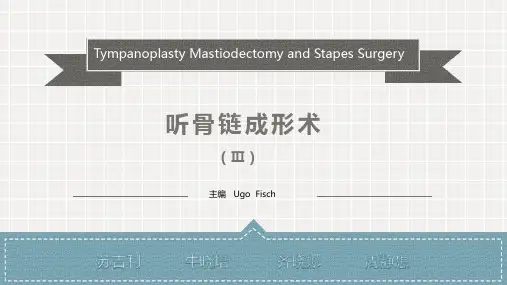
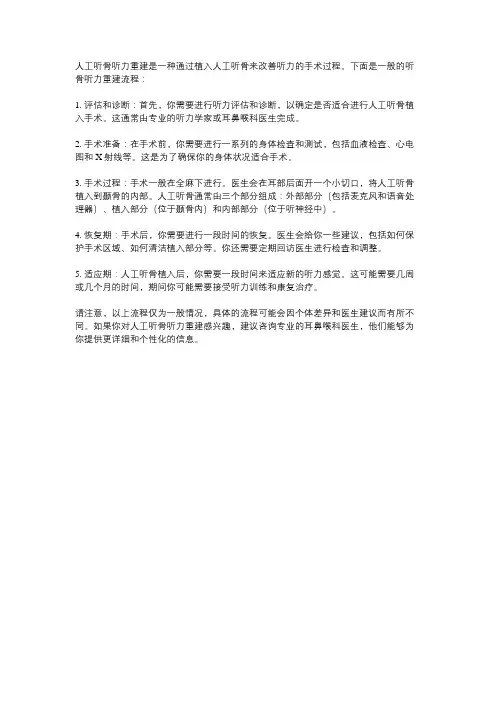
人工听骨听力重建是一种通过植入人工听骨来改善听力的手术过程。
下面是一般的听骨听力重建流程:
1. 评估和诊断:首先,你需要进行听力评估和诊断,以确定是否适合进行人工听骨植入手术。
这通常由专业的听力学家或耳鼻喉科医生完成。
2. 手术准备:在手术前,你需要进行一系列的身体检查和测试,包括血液检查、心电图和X射线等。
这是为了确保你的身体状况适合手术。
3. 手术过程:手术一般在全麻下进行。
医生会在耳部后面开一个小切口,将人工听骨植入到颞骨的内部。
人工听骨通常由三个部分组成:外部部分(包括麦克风和语音处理器)、植入部分(位于颞骨内)和内部部分(位于听神经中)。
4. 恢复期:手术后,你需要进行一段时间的恢复。
医生会给你一些建议,包括如何保护手术区域、如何清洁植入部分等。
你还需要定期回访医生进行检查和调整。
5. 适应期:人工听骨植入后,你需要一段时间来适应新的听力感觉。
这可能需要几周或几个月的时间,期间你可能需要接受听力训练和康复治疗。
请注意,以上流程仅为一般情况,具体的流程可能会因个体差异和医生建议而有所不同。
如果你对人工听骨听力重建感兴趣,建议咨询专业的耳鼻喉科医生,他们能够为你提供更详细和个性化的信息。


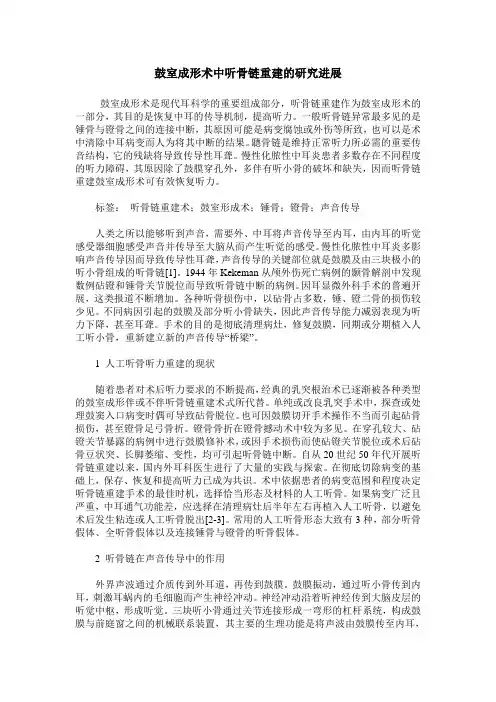
鼓室成形术中听骨链重建的研究进展鼓室成形术是现代耳科学的重要组成部分,听骨链重建作为鼓室成形术的一部分,其目的是恢复中耳的传导机制,提高听力。
一般听骨链异常最多见的是锤骨与镫骨之间的连接中断,其原因可能是病变腐蚀或外伤等所致,也可以是术中清除中耳病变而人为将其中断的结果。
聽骨链是维持正常听力所必需的重要传音结构,它的残缺将导致传导性耳聋。
慢性化脓性中耳炎患者多数存在不同程度的听力障碍,其原因除了鼓膜穿孔外,多伴有听小骨的破坏和缺失,因而听骨链重建鼓室成形术可有效恢复听力。
标签:听骨链重建术;鼓室形成术;锤骨;镫骨;声音传导人类之所以能够听到声音,需要外、中耳将声音传导至内耳,由内耳的听觉感受器细胞感受声音并传导至大脑从而产生听觉的感受。
慢性化脓性中耳炎多影响声音传导因而导致传导性耳聋,声音传导的关键部位就是鼓膜及由三块极小的听小骨组成的听骨链[1]。
1944年Kekeman从颅外伤死亡病例的颞骨解剖中发现数例砧镫和锤骨关节脱位而导致听骨链中断的病例。
因耳显微外科手术的普遍开展,这类报道不断增加。
各种听骨损伤中,以砧骨占多数,锤、镫二骨的损伤较少见。
不同病因引起的鼓膜及部分听小骨缺失,因此声音传导能力减弱表现为听力下降,甚至耳聋。
手术的目的是彻底清理病灶,修复鼓膜,同期或分期植入人工听小骨,重新建立新的声音传导“桥梁”。
1 人工听骨听力重建的现状随着患者对术后听力要求的不断提高,经典的乳突根治术已逐渐被各种类型的鼓室成形伴或不伴听骨链重建术式所代替。
单纯或改良乳突手术中,探查或处理鼓窦入口病变时偶可导致砧骨脱位。
也可因鼓膜切开手术操作不当而引起砧骨损伤,甚至镫骨足弓骨折。
镫骨骨折在镫骨撼动术中较为多见。
在穿孔较大、砧镫关节暴露的病例中进行鼓膜修补术,或因手术损伤而使砧镫关节脱位或术后砧骨豆状突、长脚萎缩、变性,均可引起听骨链中断。
自从20世纪50年代开展听骨链重建以来,国内外耳科医生进行了大量的实践与探索。
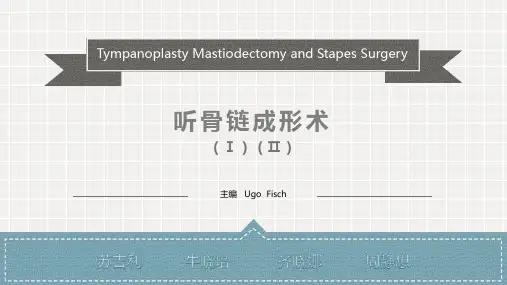
ABSTRACTBackground Ossicular chain is located in tympanic cavity, composing by malleus, incus and stapes. Many reasons contribute to the destruction of ossicular chain, resulting in conduction deafness. Reconstruction of ossicular chain is the effective method to heal the conduction deafness. The dates about reconstruction of ossicular chain are abundant,therapeutic effect is stable,but the rate of exodus and ineffective are the matter. Dates about ossicular chain are centered in the stapes,others are seldom. Dates on the anatomy of ossicular chain are important to the achievement ratio of operation,decrease the rate of exodus,resulting in the elevation of audibility threshold.Cochlea getting its name because of the shape to resemble volute, is a projecting in an anterior direction of from the vestibule. Cochlea is composed of modiolus and cochear spiral canal. Osseous spiral lamina around modiolus,divide the cochear spiral canal into scala vestibule, scala tympani, and cochlear duct. The scala vestibule and scala tympani communicate with each other through helicotrema. Cochlear duct occupying the middle part of the cochlear canal between the scala vestibule and the scala tympani, is a spiral blind tube fixed firmly to the internal and external walls of the cochlear canal of the bony labyrinth. The spinal organ, the receptor of auditory stimuli, is situated on the basilar membrane of the cochlear duct.Artificial cochlea is a auditory prosthesis to stimulate the cochlear function used to cure the extremely heavily neurosensory deafness,containing two parts,language treater and implant button. The key technique is drilling hole to implant the electrode into SV or ST.The procedure s are follows:1.Rubbing a bony bed above acoustic duct to place the voice receiver and stimulator.2.The classic mastoid process approach: contouring the circumscription, enter tympanic cavitythrough facial recess, wearing out the bone before anterior magin of cochlear window to expose the ST and insert the electrode into ST or insert the electrode through secondary tympanic membrane.3.Middle cranial fossa approach: opening a window on temporal squama, draft the brain,dissociate the cerebral dura mater, expose the undersurface of middle cranial fossa. Rubbing the surface bone of basal turn,insert the electrode into cochlea.Objective To provide anatomic data for reconstruction of auditory ossicular chain and cochlear implantation via tympanic cavity and the middle cranial fossa,and find the method of locating the cochleostomy site(CS).Methods Micranatomical study was carried out on 30 sides of human temporal bones to measure the location of umbo in tympanic membrane,the distance between handle of malleus and head of stapes,the diameter of handle of malleus and so on. Observing and measuring bony spiral lamina below promontory,including its location,course and adjacent structures. Observing and measuring the depth from the crista petrosa to the superior portion of the basal turn (SPBT) and distances from the facial,greater petrosal nerves and the round window.Results1.The distance between handle of malleus and stapes head was (2.38±0.19)mm(2.00~2.70mm),the point selecting for measuring were outer margin of handle of malleusand head of stapes.2.The cross section form of inferior one-third of the handle of malleus was triangle, theanteroposterior diameter of handle of malleus was (0.79±0.12)mm, the exterior and interior diameter was (0.58±0.10)mm at the crook point;angle of line of handle of malleus laid(83.24±8.33)°(66~98°) posteroinferior to zygomatic arch.3.The long axis of prosthesis form (27.60±1.75)° (24.6~30.2°) angle with the perpendicular ofstapes.4.The dependablity between the malleus-stapes distance and transverse diameter of tympaniccavity,the location of umbo in tympanic membrane,the diameter of manubrium mallei,angle of line of manubrium mallei and arch of zygoma are not statistically significant.5.The basal turn spiral lamina below promontory can be divided into three segments: the hooksegment of (1.52±0.16) mm,the anteroinferior round window segment of (3.83±0.37)mmand the forwarding segment of (2.70±0.36) mm by two hinge points of which one was located at anterior of the junction of superior margin and anterior border of RW,the other was located at anteroinferior of the round window.6.The plane of anteroinferior round window segment of BSL lay(51.00±5.97) ° anteroinferiorto horizontal segment of the facial nerve and comparative permanently meet posterior margin of stapes head; Made posterior margin of stapes head as a fixation point and draw a line on promontory lay (51.00±5.97) ° anteroinferior to horizontal segment of the facial nerve, then this line can be thought as the projection of anteroinferior round window segment of BSL on promontory.7.The depth from the petrosal crest to SPBT of the cochlea was (8.58±2.28)mm. Distancesfrom the cochleostomy site to the fundus of internal acoustic meatus(IAM),to the greater superficial petrosal nerve(GSPN),to the labyrinthine portion of the facial nerve(FN),and to the superior semicircular canal(SSC) was (1.47±0.30)mm, (3.88±0.52)mm, (2.80±0.26)mm,(9.46±1.01)mm respectively.8.The length of scala tympani from the cochleostomy site to the round window was(12.03±1.26)mm.9.The bend portion of internal carotid artery (ICA) located medial and inferior to the basal turnof the cochlea. The bony interval between the cochlea and the ICA canal was(1.54±0.47)mm,the depth from SPBT to the ICA was (6.67±2.07)mm.Conclusion1.The distance between handle of malleus and stapes,the diameter of handle of malleus areimportant to the design of prosthesis.2.The long axis of prosthesis form less than a 30° angle with the perpendicular of stapes,thestrength contributed to inner ear is about eighty-nine percent of virgin power,the strength contributed to transversal is forty-six percent.3.The basal turn spiral lamina below promontory can be divided into three segments (the hooksegment, the anteroinferior round window segment and the forwarding segment) by two hinge points.4.The projection of anteroinferior round window segment of BSL and the features exhibited inits course provide reference for locating the basal turn scala tympani and offer firm anatomical basis for minimal invasive intervention during cochlear implantation.5.Greater petrosal nerve was identification of cochleostomy, the labyrinthine portion of thefacial nerve was the important anatomic structure should be protected.Key words Auditory ossicles; Ossicular prosthesis; osseous spiral lamina; Facial nerve; Greater petrosal nerve; Cochlear implantation;Middle cranial fossa approach; Applied anatomy英文缩略词表site 电极植入点CS CochleostomyEAS Combined electric-acoustic stimulation 声电联合刺激nerve 面神经FN Facialganglion 膝神经节GG GeniculateGPN Greater petrosal nerve 岩大神经IAM Internal acoustic meatus 内耳道ICA Internal carotid artery 颈内动脉OSL Osseous spiral lamina 骨螺旋板OW Ovalwindow 前庭窗window 蜗窗RW RoundASC Anterior semicircular canal 前半规管tympani 鼓阶ST Scalavestibuli 前庭阶SV Scalacavity 鼓室TC Tympanicganglion 三叉神经节TG Trigeminal中文摘要 -----------------------------------------------------Ⅰ英文摘要-----------------------------------------------------Ⅳ缩 略 词-----------------------------------------------------Ⅷ目 录 -----------------------------------------------------Ⅸ实验研究前 言-----------------------------------------------------(1) 第 一 部分 听骨链重建术的相关解剖测量------------------------(2) 第 二 部分鼓岬区骨螺旋板的分段定位及其临床意义-------------(7) 第 三 部分经颅中窝入路植入人工耳蜗的应用解剖---------------(13)结 论-----------------------------------------------------(18)附 图-----------------------------------------------------(19)综 述综 述 一 人工耳蜗植入术相关的耳蜗解剖学-------------------(25)综 述 二 人工耳蜗植入手术方式及对耳蜗的损伤---------------(30)参考文献-----------------------------------------------------(34)附 录-----------------------------------------------------(38)致 谢-----------------------------------------------------(39)听骨链位于中耳鼓室内,由锤骨、砧骨和镫骨组成,可因多种疾病导致听骨链的完整性遭到破环,从而导致传导性耳聋。